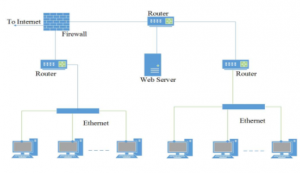Subnetting
Question 1 |
Consider an enterprise network with two Ethernet segments, a web server and a firewall, connected via three routers as shown below.

What is the number of subnets inside the enterprise network?

What is the number of subnets inside the enterprise network?
3 | |
12 | |
6 | |
8 |
Question 1 Explanation:
It can be seen as Non equal subneting.
Where router 2 (via Firewall) has the half of the addresses.
Router 1 (via web server) has other half which is further divided into two subnets which is web server and router 3. So total of 3 subnets possible.
Where router 2 (via Firewall) has the half of the addresses.
Router 1 (via web server) has other half which is further divided into two subnets which is web server and router 3. So total of 3 subnets possible.
Question 2 |
Consider routing table of an organization’s router shown below:

Which of the following prefixes in CIDR notation can be collectively used to correctly aggregate all of the subnets in the routing table?

Which of the following prefixes in CIDR notation can be collectively used to correctly aggregate all of the subnets in the routing table?
12.20.164.0/20 | |
12.20.164.0/22 | |
12.20.164.0/21 | |
12.20.168.0/22 |
Question 2 Explanation:
Do bit wise and with the given subnet and subnets mask then compare to given choices IP address range.
Question 3 |
In the network 200.10.11.144/27, the fourth octet (in decimal) of the last IP address of the network which can be assigned to a host is ____________.
158 | |
157 | |
156 | |
155 |
Question 3 Explanation:
No. of bit in HID part = 32-27 = 5 bits
Subnet mask is 255.255.255.224
Do AND with given IP and subnet mask then we get NID 200.10.11.128
In fourth octet first three bit will fixed for subnet and remaining 5 bits is for HID, so maximum value as 11111.
The address with all 1s in host part is broadcast address and can't be assigned to a host.
So the maximum possible last octal in a host IP is 10011110 which is 158.
Subnet mask is 255.255.255.224
Do AND with given IP and subnet mask then we get NID 200.10.11.128
In fourth octet first three bit will fixed for subnet and remaining 5 bits is for HID, so maximum value as 11111.
The address with all 1s in host part is broadcast address and can't be assigned to a host.
So the maximum possible last octal in a host IP is 10011110 which is 158.
Question 4 |
Consider the following routing table at an IP router:

For each IP address in Group I identify the correct choice of the next hop from Group II using the entries from the routing table above.
Group I Group II
(i) 128.96.171.92 (a) Interface 0
(ii) 128.96.167.151 (b) Interface 1
(iii) 128.96.163.121 (c) R2
(iv) 128.96.165.121 (d) R3
(e) R4
i-a, ii-c, iii-e, iv-d | |
i-a, ii-d, iii-b, iv-e | |
i-b, ii-c, iii-d, iv-e | |
i-b, ii-c, iii-e, iv-d |
Question 4 Explanation:
Do the AND operation of group I IP address with Netmask and compare the result with network number. if it match with network number, forward packet through that interface.
Ex: 128.96.167.151 AND 255.255.254.0 = 128.96.166.0
Therefore packet will forward through R2.
There are 4 questions to complete.
